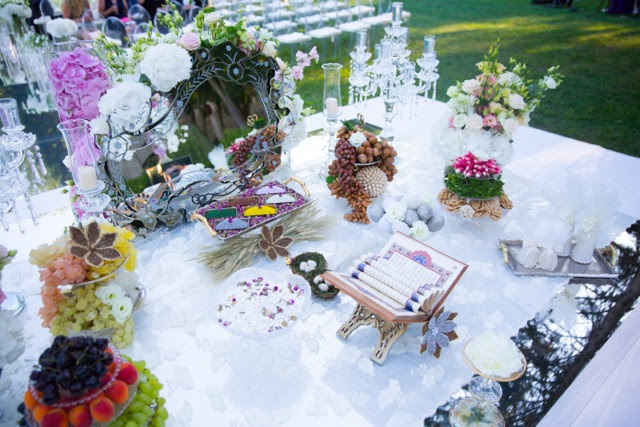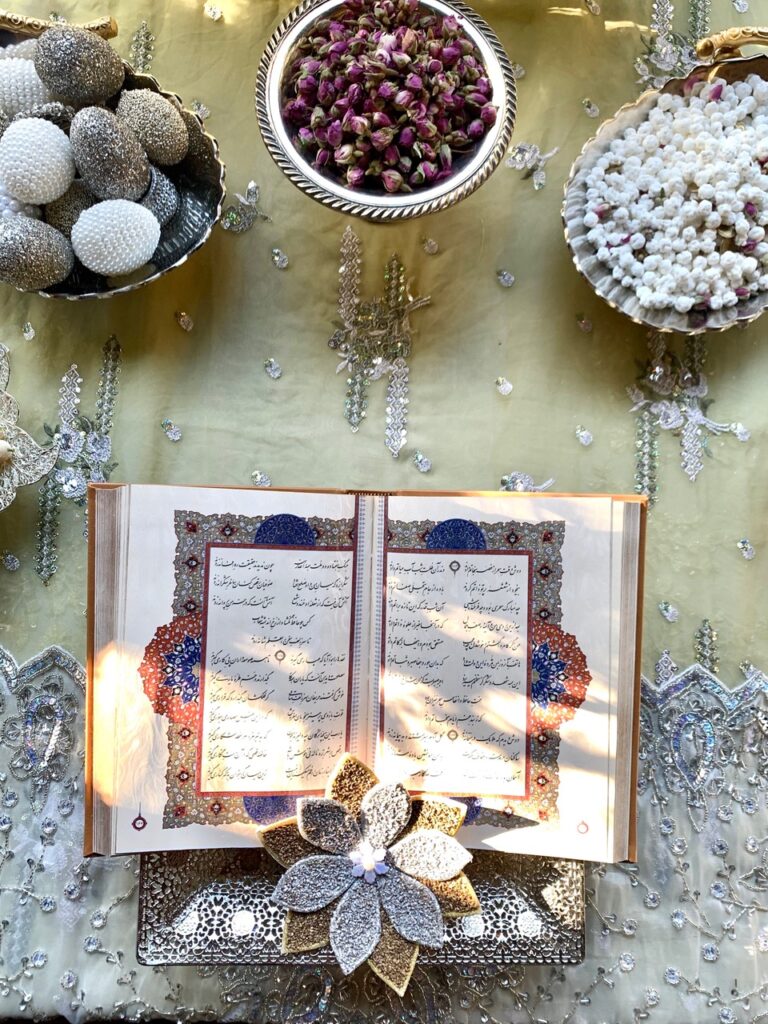A guest post by Nilou Nouri
Nilou has been serving as a Persian wedding officiant for many years – and has frequently done so for weddings by A Day Like No Other.
All weddings, as celebrations of union between two individuals, are filled with ritual. Some rituals are, for the most part, universal, such as wearing white by the bride, or the exchange of rings and exchange of vows. Some rituals vary depending on the cultural backgrounds of the families. Many rituals of food are used during the ceremony, to symbolize sweetness (sharing honey) or the bitter-sweetness of marriage (sharing sugar-covered almonds), etc. Some rituals symbolize the binding of the union of two individuals (hand-fasting, lasso-ceremony, chuppah or the sugar-rubbing cloth held overhead the couple) and some rituals highlight the coming together of two families and communities (unity candle lighting, ring warming ceremony, etc.).
The Iranian (Persian) ceremony is full of beautiful, meaningful rituals, all of which point to nature, love and the spiritual world. And, unlike many wedding ceremonies worldwide, where religion plays a central role, the Iranian (Persian) ceremony is entirely secular. All of its elements point to nature, beauty and love between the couple. Additionally, there is great emphasis on the importance of literature by reciting beautiful love poetry of classical Persian poets such as Khayyam, Hafez, Rumi and others.

During their nuptials, the couple sits in front of a decorative spread, Sofreh Aghd, with items symbolizing well-wishes for their married life. These include a mirror (for reflection), candles (light in the universe), crystalized sugar (sweetness), eggs and nuts (fertility), flowers (beauty), herbs and fruit (health), bread (sustenance), spices (to ward off any negative energies) and a book (usually poetry or holy book depending on the preferences of the couple). In addition to these items, two large sugar cones as well as a container of honey will adorn the Sofreh and will be used during the ceremony. The cones (which represent the couple) will be rubbed together over a cloth held over their heads, in the hopes that every contact between the couple will result in sweetness! The honey will be used by the couple to take turns feeding to one another with their pinky fingers and also symbolizes sweetness for their marriage.

During the Persian wedding ceremony, the Officiant asks the couple for their declaration of consent. While the groom answers with a loud and resounding “ba’leh”, or “Yes!”, the bride traditionally would not respond the first nor the second time that the question is asked. During this silence, her girlfriends would chime in and say, “the bride has gone to pick flowers” or “the bride has gone to bring rosewater”. In the old days, the groom would be seated outside of the ceremony room (which was traditionally a female space) and the bride’s girlfriends would tease him and say “she’s not here, she’s gone to pick flowers”! Another reason for this delay may have been to allow the bride to consider the decision that would forever change her destiny.

After the couple has given their consent, they share their vows and rings and feed each other honey! At the end of the ceremony, the close relatives of the couple will present their ceremony gifts (usually jewelry or envelopes with cash) before the couple is announced and shares their first kiss as married!
Today many couples choose to modify the ceremony to fit their wishes, beliefs, budgets and preferences. Some will have an elaborate Sofreh of considerable proportions, and some will display a modest version with a few key items. For couples who are celebrating a mixed union, coming from different traditions, many times on the Sofreh will be displayed items reflecting their backgrounds. For example, in my work with mixed/fusion couples, I have seen everything from an Irish horseshoe and Child of Prague statue, to a Mexican lasso and coin, to the Native American basket, to the Jewish wine glass and the African American broom, among other items. These objects fit beautifully together and are a testament to love, union and mutual acceptance between two individuals, their families and communities.
Every wedding is so very special and such a happy occasion. Afterall we are celebrating the greatest force in the universe, Love! So regardless of size, venue, expense and any fanfare, the true essence of every wedding is the celebration of a union, and the coming together of families and communities. Rituals help to make this special occasion even more meaningful and memorable.



